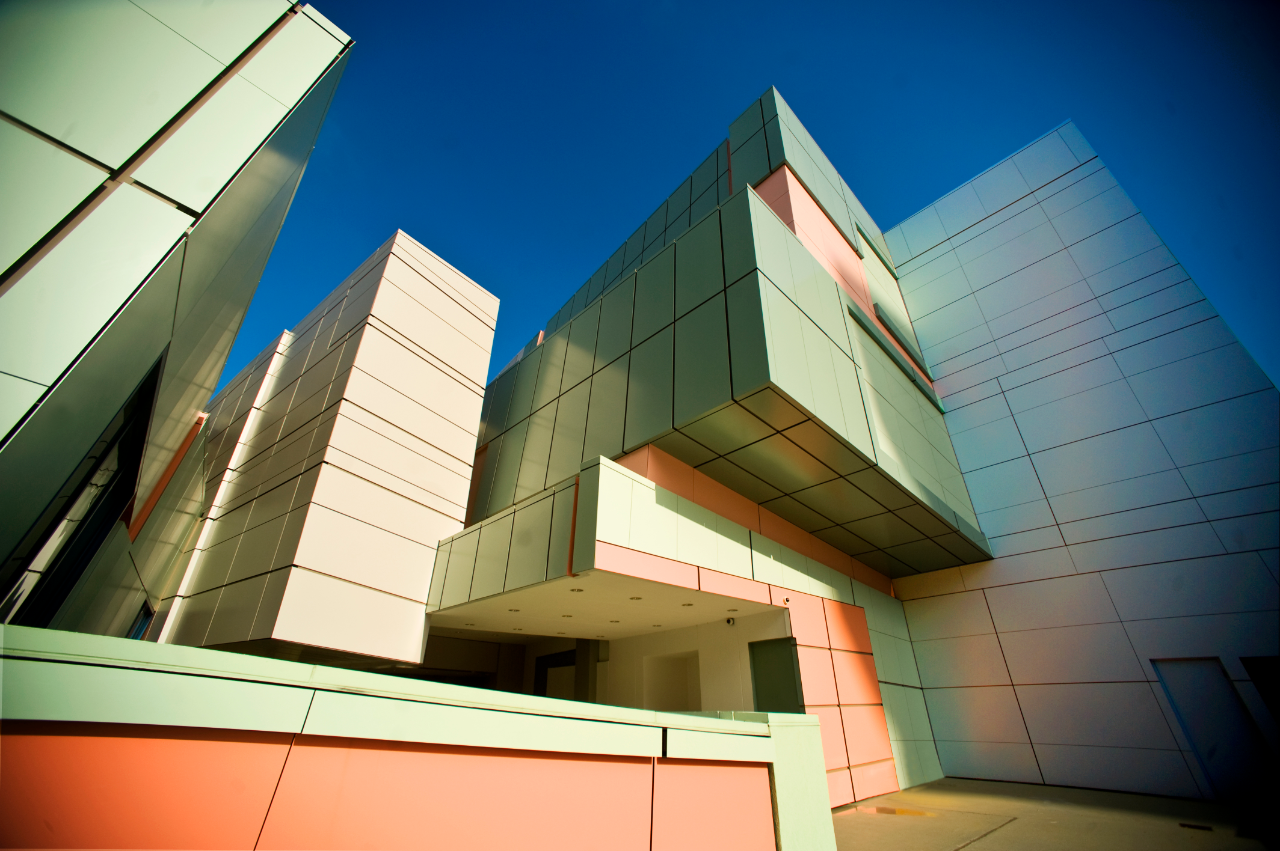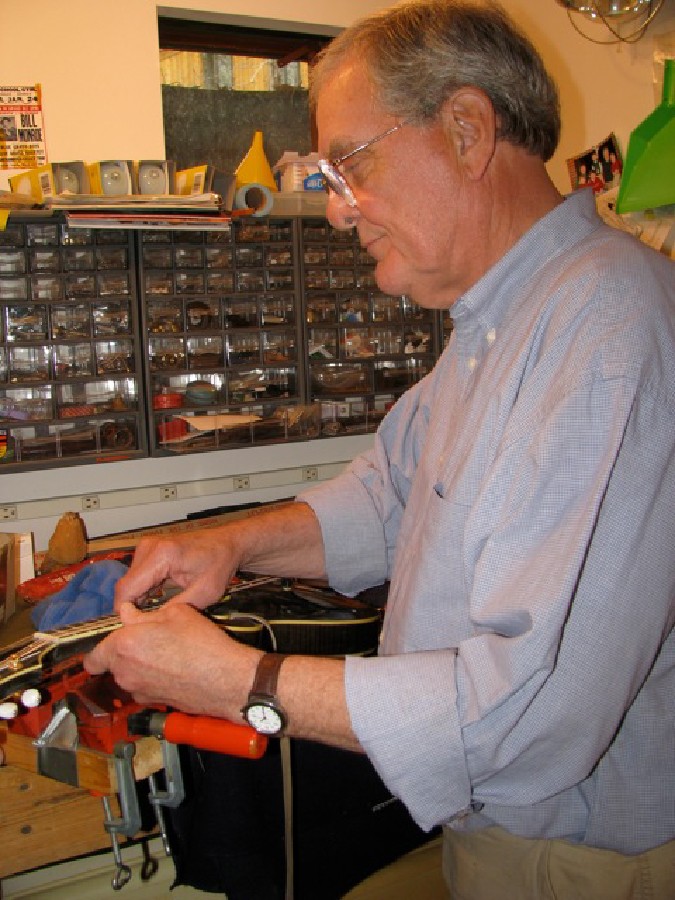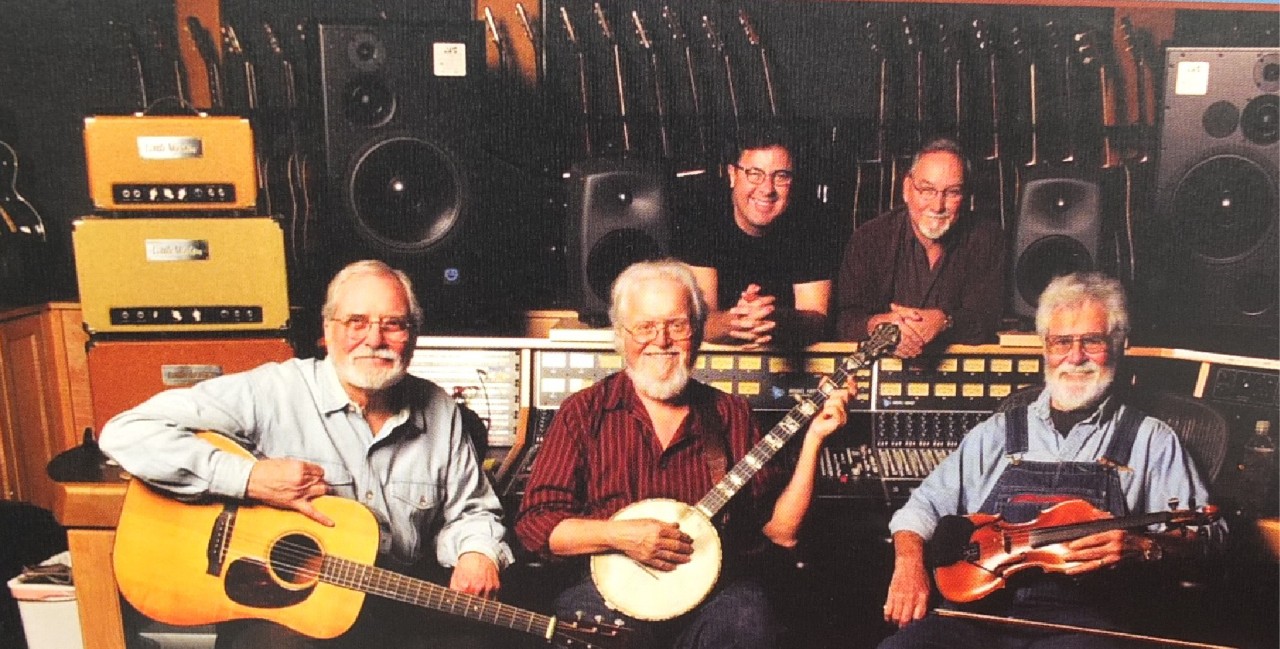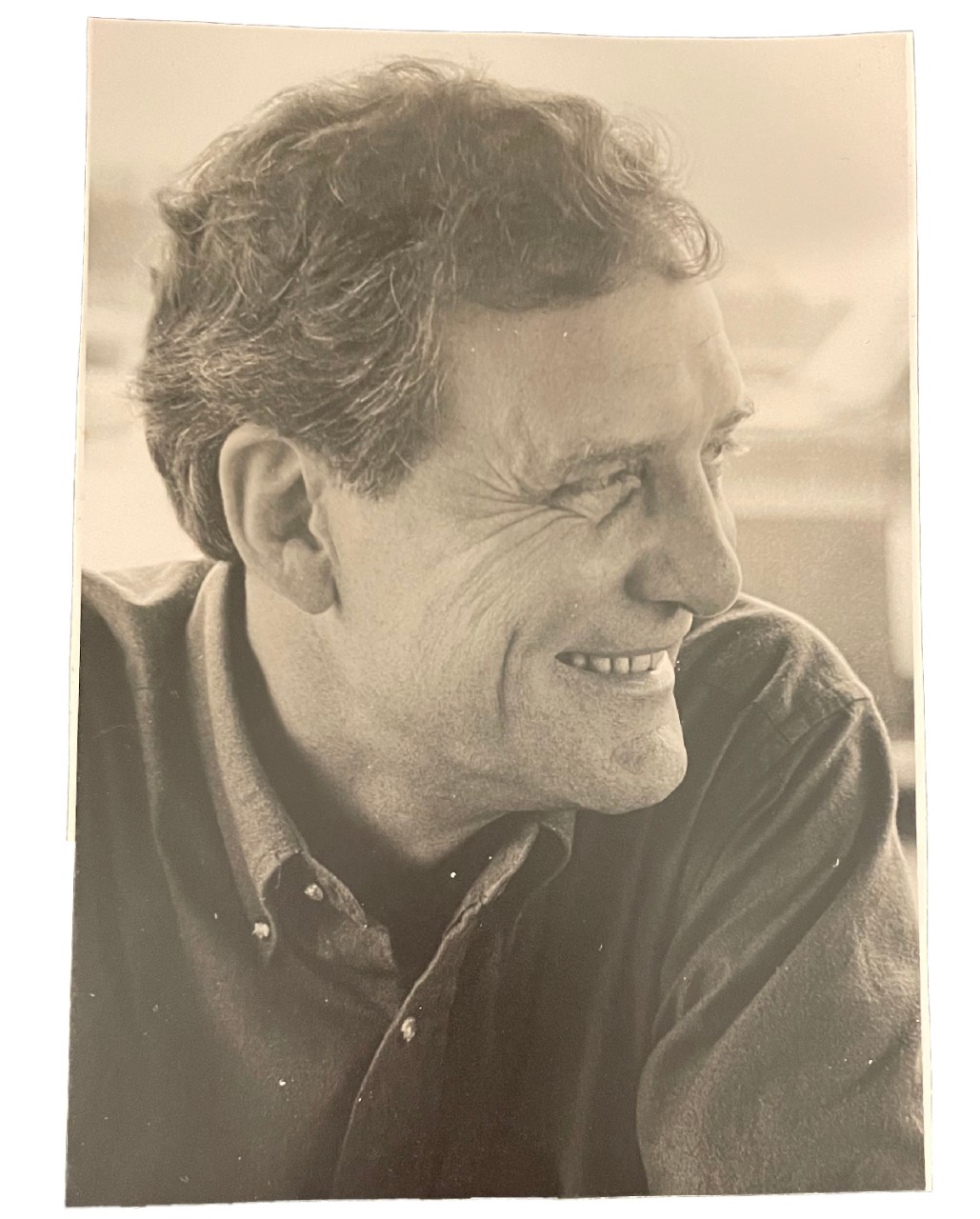
Harry Sparks: architect, luthier to the stars, competitor, ADA pioneer and so much more

Harry Sparks repairing an instrument. Photo/Northern Kentucky Tribune
Alumnus Harry Sparks is the ultimate go-to guy. An architecture graduate (‘67 ), he has built or remodeled countless retail institutions (think Bloomingdale’s, Macy’s and Home Depot), casinos, hotels and even the famous Rabbit Hash, Kentucky, General Store, where the tiny town has a dog as its mayor. But that’s just been his day job. After hours, Harry has spent the last 60 years as one of country music’s premier luthiers. Superstars like Vince Gill and Sam Bush come to Harry for acoustic instrument work.
Harry also has a competitive side: sailboat racing and participating in shooting matches across the globe as a member of the Muzzle Loaders International Confederation (MLAIC). He also finds time for hunting and fly fishing.
Then there’s his groundbreaking work on facility accessibility during the Carter administration. He testified before Congress and his input eventually helped craft the Americans with Disabilities Act of 1990.
Like many DAAP grads, Harry gleaned a multi-disciplinary approach to problem solving and developed an entrepreneurial approach to not just his career, but life itself.
The Kentucky native, now a spry 81 years old, always starts his remarkable story with high school. “I was third from the bottom of my high school class,” he recalls. “Every time I was supposed to be writing I was drawing.”
He was fortunate to matriculate to Murray State in Kentucky where his mother happened to be the school librarian and his father an education professor who would later be tapped as president of the college.
“I was an odd ball student with my almost one-foot long slide rule on my belt and an easel under my arm,” he recalls. “I seemed to be the only engineering major to take art classes. But taking art was my life-changing experience.”
The life-changer was art professor Clara Eagle, now the namesake for the Murray State Art Department.
“Clara looked like a truck driver with a Pall Mall always dangling from her mouth. But she got to know each student well. She knew I worked in construction during the summers and when she put everything together she told me in no uncertain terms who I was.”
“You are an architect,” she declared. “You mix art, math and engineering. You need to get out of Murray and from under the shadow of your parents.”
Harry happened to know Dr. Ralph Tesseneer who was a professor at Murray State University and later the Interim President of Northern Kentucky University. He encouraged Harry to heed Ms. Eagle’s advice. He suggested the University of Cincinnati, renowned for its architecture department as well as the co-op program. The decision was made. Though he was leaving his third year at Murray, he started over as a freshman at UC. Phi Kappa Alpha welcomed him as one of their own as did the DAAP department faculty.
“With my dismal grades, I wondered how I even got in. But University of Cincinnati President Dr. Walter Langsam knew my dad through the National Education Association (NEA). That’s also probably how I received a hand-written note from Dr. Langsam. Later I discovered that when the DAAP admissions director quizzed me, he said I was the only one who ever said, ‘If you let me in I promise you I’ll graduate.’”
Harry co-opped at an engineering firm as well as several architectural firms drawing bridges and other city infrastructure and architectural projects. “What a God-send. It was a terrific experience!”

The original Buzzard Rock String Band with, (top row) Vince Gill and Charlie Cushman and front row, left to right: Harry Sparks, Harry Bickel and Doc Hamilton. Photo/Northern Kentucky Tribune.
Of course at night he was supplementing his co-op income by singing and playing with a bluegrass group comprised of DAAP students. They were invited to play at Rabbit Hash along the Ohio River where a folk festival was taking place.
“Then someone asked us the name of our band and we made up a name on the spot: Rabbit Hash Ramblers. We played together under that name for 11 years.”
Along the way he perfected his tinkering skills into being one of the most successful luthiers around, specializing in repairing guitars, banjos and mandolins. Robbie Robinson, a Columbus mandolin player, took Harry under his wings and taught him all about blue grass music and instruments. Harry was a quick learner. He discovered later that he was dyslexic, then realizing why reading had been so difficult. Unfortunately, his daughter Jill inherited the challenge.
A Rocky Mountain high
While gaining co-op experience Harry played with additional musical groups including the Queen City Balladeers. One day The Mitchell Trio (previously known as The Chad Mitchell Trio) was booked to play across the street from DAAP. A man named John Deutshendorf took Chad’s place that night and for some time after. Unexpectedly, a banjo was on the fritz. The man helping the group set up at the Wilson Auditorium, Mike Zwertchek, said that when band member Paul’s banjo needed repair, he simply said, “Call Harry Sparks. He’s an architecture student and is a whiz at fixing string instruments.”
“I came to the auditorium with a bag of tools and fixed Paul Prestopino’s banjo. They offered to pay me, but I declined. It was such a pleasure to be in the company of these professionals.”
Deutshendorf happened to have studied architecture too and was elated to have an expert nearby to repair the instrument. The Trio played until 11 p.m. and then signed autographs while Harry’s group played at the Candlelight Café at the other end of campus. The Trio came to the Candlelight Café and they all ended up jamming together into the wee hours of the morning.
A couple of years later, Deutshendorf tracked down Harry to repair a guitar. He said, “Oh, by the way, I’ve changed my name to John Denver.”
Denver took a cab to Harry’s house and chatted while Harry repaired his guitar. From then on Harry received backstage passes whenever his friend John Denver was in town. He even got a frantic call to come to Denver’s home in Aspen. So he got a true “rocky mountain high” as he spent a week there taking apart the banjo of Denver’s band member John Sommers and putting it together with a new tone ring. Sommers is the composer of the hit, “Thank God I’m a Country Boy.”
Harry’s DAAP thesis was on a Louisville school for the blind about which, he quipped “no one could see it.”
But things got serious when he discovered that his sixth grade teacher happened to be the school’s principal. Harry created a tactile environment. He learned that two out of three visually impaired people have at least one additional physical problem. His project that centered on facilities friendly to the disabled was the first of its kind. Harry’s groundbreaking paper on architectural designs for the disabled resulted in national speaking invitations to discuss physical environments for the disabled. The crowning achievement was speaking before congressional committees on the needs of the physically challenged. The Americans with Disabilities Act of 1990 embraced much of his architectural input.
He eventually ended up working at the University of Louisville, where he worked on facilities, and later, the Council for Higher Education in Frankfort, Kentucky.
Many DAAP alums associate Harry as the founder of Architectural Group International (AGI), a Covington, Kentucky-based firm specializing in hospitality and retail. Some of their signature projects have included Bed, Bath & Beyond, renovating Home Depots across the nation, the Cincinnati Reds Hall of Fame and the Green Bay Packers Hall of Fame. The firm also worked on the renovation of the famed Tropicana casino in Las Vegas.
AGI renovated and designed several Macy’s and Bloomingdale’s locations. It holds a sweet spot for Harry. He worked for Federated Department Stores, the precursor to Macy’s and owner of Bloomingdales and many other department stores. He met his wife, Carol, at Federated where she was the Operating Vice President of Employee Relations.
From sailboat living to the Chicago suburbs
Prior to joining Federated, Harry was living the dream on a sailboat off the shores of Florida. He became a competitive sail boater and fly fisherman while also travelling the globe designing shopping centers, banking centers and restaurants. But his young son was hanging with the wrong crowd. He came to live with Harry.
“I took a job in the Chicago area with Mainstreet Department Stores, a division of Federated Department Stores. I was Mr. Mom,” he recalls. “One day I got a call from my son’s high school theatre advisor who said she had never had a student like this in her career. I sat at my desk and cried. I was so very moved by that phone call.”
Everything worked out. Son Hal Sparks is now an accomplished TV and film actor, director, singer, musician and comedian. He even had his own special on Showtime. Google him to get the full impact of Hal’s work. He lives life with the same fervor as his father.
Hal saw Harry do amazing things while at Federated. He built the $32 million Bloomingdale’s in Minnesota’s Mall of American in a record 14 months. He also commuted to New York three times a week to discuss the various Bloomingdale’s across the nation either being built or remodeled under his supervision.
After 15 years at Federated, Harry was ready to open his own shop. He confided to Carol that architects working for Federated were not enthralled with architectural remodeling and doing a relatively poor job. This seemed a perfect niche for his new firm.
Shortly before leaving Federated he had a serendipitous encounter. On a flight to Kentucky, while in the queue to be the 47th plane to depart, he sat next to a man from Northern Kentucky named Bill Butler. They began to talk as Butler shared some criticism he had received on the two towers he had designed to be built on the Kentucky side of the Ohio River facing Cincinnati. It seems that some authorities were appalled that one of the RiverCenter towers was designed to be taller than the other.
Harry used his DAAP knowledge to assure Butler that most historic European architecture, especially cathedrals, were built this way. No two adjoining structures were rarely the same height. Butler was thankful for the information and offered Harry an office in the building’s Executive Suites where AGI was born.
Soon Harry grew from one to four offices. Then took half a floor. Revenue grew considerably.
“I may have been small and growing, but we knew what we were doing,” says a confident Harry. “I went to the Home Depot headquarters to take my pitch for their business and the guy thought I was nuts. Then I saw a Porsche emblem on his shirt. I told him I drove a Porsche. We talked cars then music.”
“Who is your favorite guitar player?” Harry asked.
“Vince Gill,” he replied.
“I told him that Vince Gill and I are good friends. That broke the ice!”
The Home Depot executive received a CD of a Gill/Sparks performance. He was in. They gave AGI a troubled Home Depot store in Massachusetts to remodel. Since then, the firm has remodeled just about every Home Depot store in the nation.
Singing with and meeting two legends
Harry told the Home Depot executive about meeting 18-year-old Vince Gill at the repair shop he had set up with a friend in the basement of Louisville’s Harry Bickel’s Bluegrass Hotel. In fact, a few years later, Harry designed the famous Gruen’s Guitar Store in Nashville. At the grand opening Vince Gill showed up and invited Harry and Carol to check out his 2 p.m. practice session before a Saturday night concert at the famous Ryman Auditorium.
While listening to the practice session one of Gill’s band members said to Gill, “You better tell him.”
“Tell me what?”
Gill stated, “You are going to come up and play with us tonight.”
Harry admits he was “scared to death.” Carol says he turned white as a ghost. But it didn’t show.
They received a standing ovation following their performance. Harry shouted to Gill and the audience, “thank you for being part of a dream.”
Harry returned to his seat. Next to him was American documentary guru Ken Burns. He talked with Harry about his next documentary project: a series on American country and folk music.
AGI outgrew its RiverCenter offices and purchased a vacated Sears store in downtown Covington, Kentucky, that they refurbished and now call home. One day the Rabbit Hash General Store that Harry had so meticulously remodeled years ago burned to the ground.
“I got a call the next morning. My partner at the time said, ‘I know what’s going to happen. We’re going to re-do the store gratis, aren’t we?’ He could read my mind.”
What’s retirement?

Harry Sparks. Photo/Harry and Carol Sparks.
Harry’s latest interest is in competitive shooting. He won gold in the Zone Championship in Portland, Oregon, in 1997 and at the 2008 world competition in Australia.
Harry’s three-times-a-week dialysis does not slow him down. He designed their current home to make it an Earth sheltered, passive solar, geo thermal house with LED lights. Harry’s latest projects are residential: the design of a $2 million home in North Bend, Ohio, and a low-key remodel of the home that he happened to previously own in Ryland Lakes Country Club.
Is retirement in the cards? The answer is no. A doctor once asked Harry several questions including what he does to relax. “Well, I shoot in national and international competitions, race sailboats, and repair musical instruments for well-known musicians.”
The physician said, “You are the most competitive person I have ever known. Usually, when someone answers yes to three of my seven questions they are candidates for heart attacks. You need to find a way to relax.”
That won’t work for Harry. He has been curious about how things work since he was a child. He does have some advice for success for DAAP students.
“Keep an open mind. Things are changing so fast that you can’t get in a rut or you’re done. You never know what opportunity will come your way. Be flexible. I do things that I enjoy doing. Getting buildings up and everyone in them was a lot of fun. Whatever you’re going to do, try to be the best. Don’t do it for the recognition. Do it because you are trying to be good. Doing it for the recognition will always be the wrong reason
“I thanked UC and everyone there over and over. I have no idea where I’d be if it weren’t for the University, DAAP and the co-op program. They contributed to who I am today.”
By Laura Kroeger
For more information email: DAAPCommunications@ucmail.uc.edu
Impact lives here
The University of Cincinnati is leading public urban universities into a new era of innovation and impact. Our faculty, staff and students are saving lives, changing outcomes and bending the future in our city's direction. Next Lives Here.
Related Stories
UC’s human development program is world changing
March 14, 2025
The University of Cincinnati’s Human Development and Community Engagement program is offered through the School of Education (part of the College of Education, Criminal Justice, Human Services, and Information Technology) as a pathway for students to become dynamic agents of change in society.
Golden Reunion a perfect opportunity to contemplate, celebrate...
March 14, 2025
We’re all familiar with one of time’s odd characteristics: Something may have happened ages ago, but it can feel like only yesterday. Over many years, things change a lot, or maybe not at all. This feeling is occurring now within the newest members of the UC Alumni Association’s Golden Bearcats Society, which honors those who have reached the half-century mark as University of Cincinnati graduates.
UC joins novel bipolar research and clinical care network
March 12, 2025
The University of Cincinnati is one of four new national institutions to receive $2.3 million each to join the Breakthrough Discoveries for Thriving with Bipolar Disorder (BD²) Integrated Network, a collaborative research and clinical care model with a mission to improve care, interventions and outcomes for people living with bipolar disorder.